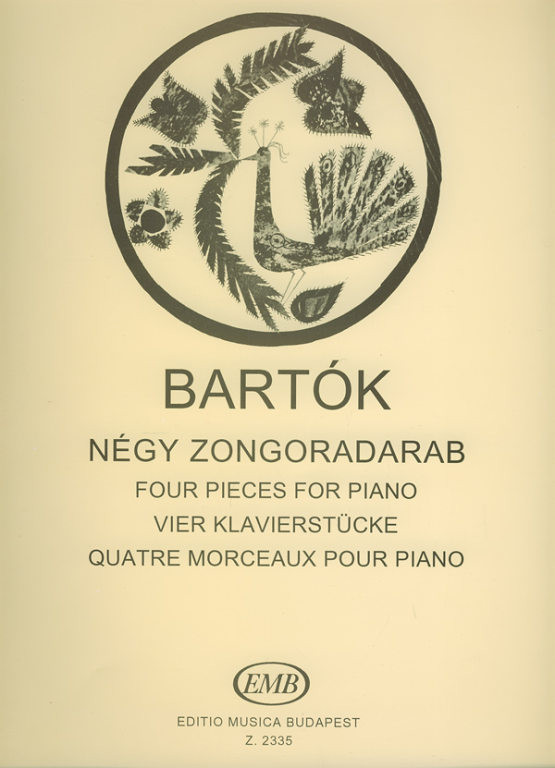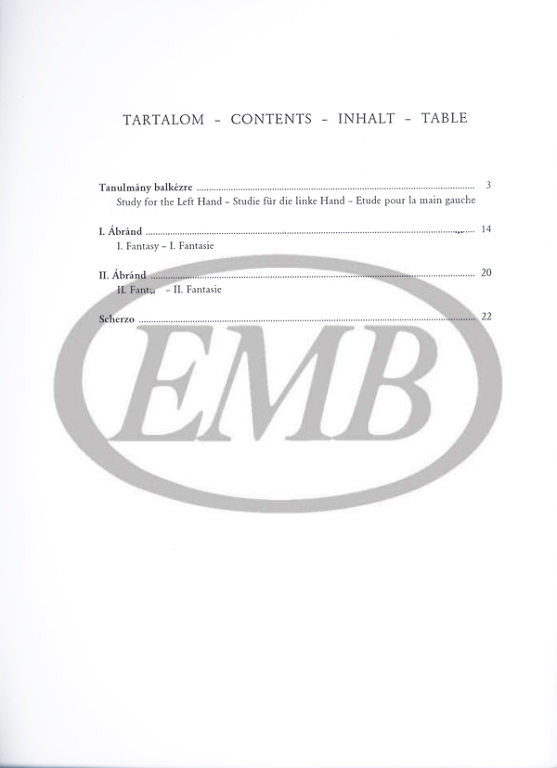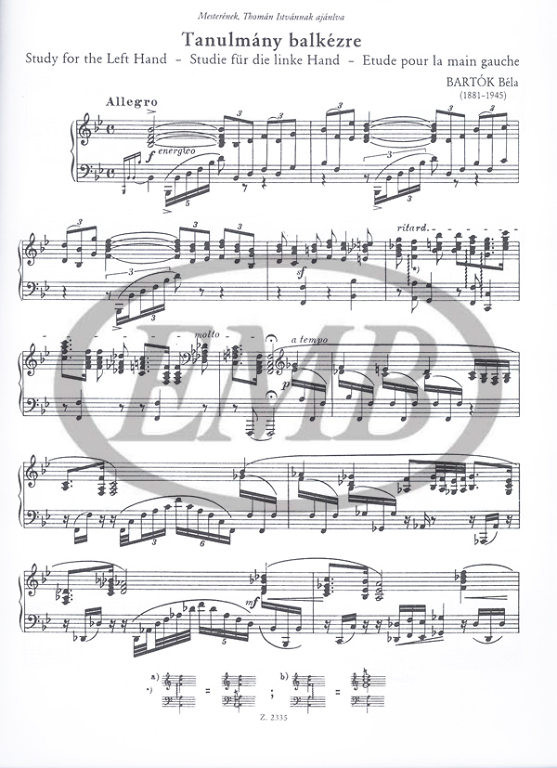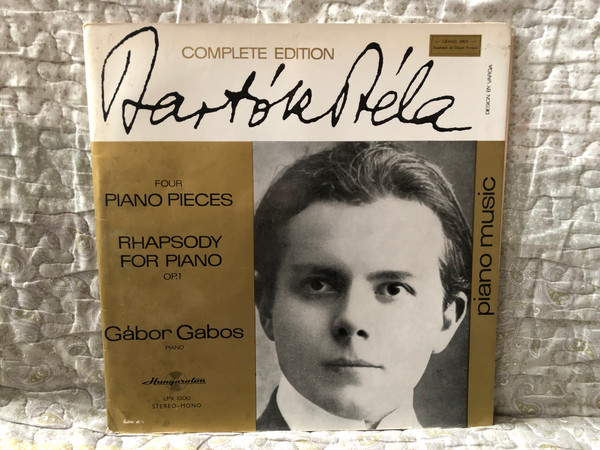Description
Early Genius: Bartók Béla's Four Pieces for Piano (Négy zongoradarab, 1903)
Product Details
- ISMN: 9790080023358 / 979-0080023358
- Item Number: 2335
- Product Type: Sheet Music (Score)
- Brand/Publisher: Editio Musica Budapest Zeneműkiadó
- Composer: Bartók Béla
- Genre: Solo Piano, Early Works
- Style: Late Romantic/Early 20th Century Hungarian Romanticism
- Setting: Piano (Zongora)
- Period: 20th Century (Composed 1903)
- Language: Hungarian (Notes often included in original edition)
- Length: 36 pages
- Format: K/4 (23.5 x 31 cm)
- Year Published: 1956
- Origin: Made in Hungary
- Weight: 0.135 kg
Overview
Four Pieces for Piano (Négy zongoradarab) offers a rare and fascinating glimpse into the compositional laboratory of Béla Bartók (1881–1945) just before his ethnomusicological revolution. Composed between January and October 1903, these pieces showcase the young composer grappling with the prevailing influences of the Late Romantic era, including Liszt and Richard Strauss, while establishing his deeply felt Hungarian romantic voice.
This score, published in 1956 by Editio Musica Budapest, contains four substantial works that demonstrate remarkable technical and emotional range: a major Study for the Left Hand, the eclectic Fantasy I, the nationalistically inspired Fantasy II, and the virtuosic, Lisztian Scherzo. These works are essential for pianists and scholars interested in tracing the evolution of Bartók's style from his grand Romantic beginnings to his later modernist folk synthesis.
Áttekintés
A Négy zongoradarab ritka és lenyűgöző bepillantást enged Bartók Béla (1881–1945) zeneszerzői műhelyébe, közvetlenül az etnomuzikológiai fordulata előtt. Az 1903 januárja és októbere között komponált darabok bemutatják a fiatal zeneszerzőt, amint megbirkózik a késő romantikus korszak uralkodó hatásaival (Liszt, Richard Strauss), miközben megalapozza mélyen átérzett magyaros romantikus hangját.
Az Editio Musica Budapest által 1956-ban kiadott kotta négy jelentős művet tartalmaz, amelyek figyelemre méltó technikai és érzelmi skálát mutatnak be: egy nagyszabású Tanulmány balkézre, az eklektikus I. ábránd, a nemzeti ihletésű II. ábránd, és a virtuóz, Lisztet idéző Scherzo. Ezek a művek nélkülözhetetlenek azoknak a zongoristáknak és tudósoknak, akik Bartók stílusának fejlődését szeretnék nyomon követni grandiózus romantikus kezdetétől a későbbi modernista népi szintéziséig.
Product Features
- Format: Paperback (Sheet Music), large K/4 format (23.5 x 31 cm)
- Pages: 36 pages
- Language: Hungarian (Score is universal, notes are Hungarian-focused)
- Instrumentation: Solo Piano
- Period of Composition: 1903
- Historical Note: The large format is typical of early 20th-century European scores, designed for readability.
Interesting Facts
- Lisztian Influence: The final movement, Scherzo, is often cited for its "scherzo diabolique" quality, directly connecting Bartók's early virtuosity to the tradition of Franz Liszt, particularly his use of grotesque and highly demanding technical writing.
- Dedication Insight: The dedications of the pieces—to Emma Gruber, his childhood friends Emsy and Irmy Jurkovics, and Ernő Dohnányi—reveal Bartók's personal relationships during this formative period. The dedication to Dohnányi is particularly significant, as Dohnányi was a leading figure in Hungarian music at the time.
- Pre-Folk Period: Composed before Bartók fully immersed himself in folk music research, these pieces demonstrate a deep engagement with the late Romantic, nationalist, and post-Wagnerian styles of the turn of the century, providing a contrast to his later, sparser style.
- A Technical Challenge: The Study for the Left Hand is a major work demonstrating the young composer’s ambition to write large-scale, technically demanding concert pieces, foreshadowing the immense challenges of his later piano repertoire.
Érdekességek
- Liszt Hatása: A záró tétel, a Scherzo gyakran a "scherzo diabolique" minőségéről ismert, közvetlenül összekapcsolva Bartók korai virtuozitását Liszt Ferenc hagyományával, különösen a groteszk és rendkívül igényes technikai írásmód használatában.
- Ajánlások: A darabok ajánlásai – Gruber Emmának, gyermekkori ismerőseinek, valamint Dohnányi Ernőnek – Bartók személyes kapcsolatait tárják fel ebben az alakuló időszakban.
- Népzene Előtti Korszak: Mivel Bartók még a népzenei kutatásba való elmerülése előtt komponálta őket, a darabok a századforduló késő romantikus, nacionalista és poszt-wagneri stílusával való mély elkötelezettséget mutatják.
- Technikai Kihívás: A Tanulmány balkézre egy nagyszabású mű, amely bemutatja a fiatal zeneszerző azon törekvését, hogy nagyszabású, technikailag igényes koncertdarabokat írjon.
Publishers
Editio Musica Budapest (EMB) As the principal publisher of Bartók's works, EMB ensures the continuing availability of these historically important, early solo piano scores, providing essential material for academic study and concert performance.
We value your feedback! Share your experience with this product to help others make informed decisions. Your review is important to us!
Hashtags
#BartokPiano #FourPiecesForPiano #EarlyBartok #Bartok1903 #StudyForTheLeftHand #RomanticPianoMusic #EditioMusicaBudapest #NégyZongoradarab #Lisztian
Hashtagek (Hungarian)
#BartókZongora #NégyZongoradarab #KoraiBartók #TanulmányBalkézre #RomantikusZongoramű #EditioMusicaBudapest #Zongorakotta #BartókBéla #Dohnányi






















